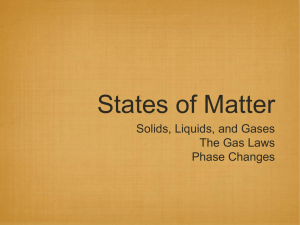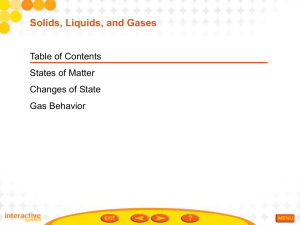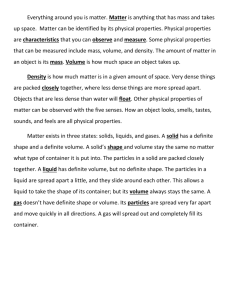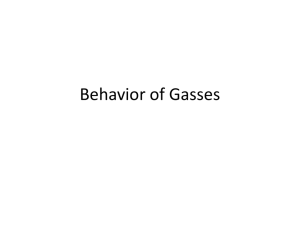Ch 3 States of Matter
advertisement
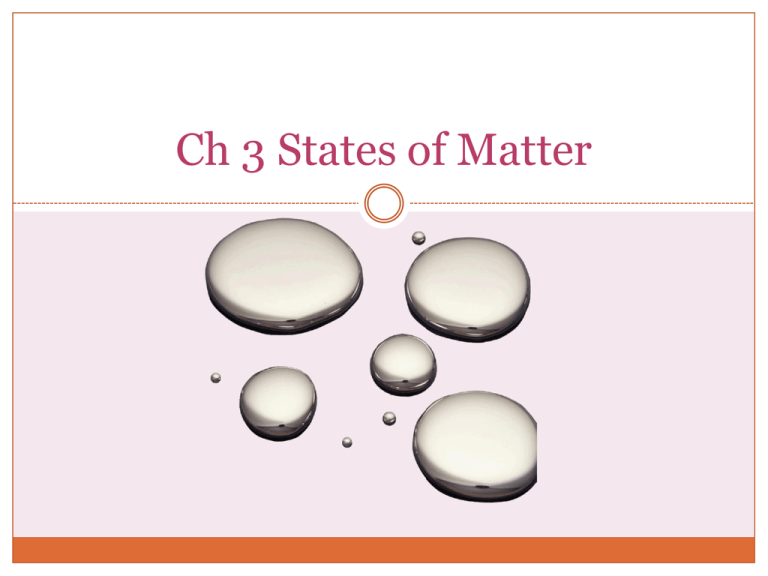
Ch 3 States of Matter States of Matter: Solids 2 Materials can be classified as solids, liquids, or gases based on whether their shapes and volumes are definite or variable. Solid is the state of matter in which materials have a definite shape and a definite volume. Almost all solids have some type of orderly arrangement of particles at the atomic level. Liquids 3 Liquid is the state of matter in which a material has a definite volume but not a definite shape. A liquid always has the same shape as its container and can be poured from one container to another. The arrangement of their atoms is more random than the arrangement of atoms in solids Gases 4 Gas is the state of matter in which a material has neither a definite shape nor a definite volume. A gas takes the shape and volume of its container. The helium atoms in a balloon are not arranged in a regular pattern. They are at random locations throughout the balloon & are never at rest. The 4th state of matter: Plasma 5 About ninety-nine percent of all the matter in the universe exists in a state that is not as common on Earth; plasma. Kinetic Theory 6 Kinetic energy is the energy an object has due to its motion. The kinetic theory of matter says that all particles of matter are in constant motion. 7 Pressure is the result of a force distributed over an area. Collisions between particles of a gas and the walls of the container cause the pressure in a closed container of gas. Factors that affect the pressure of an enclosed gas are its Temperature Volume The number particles Charles’s Law 8 French physicist Jacques Charles collected data on the relationship between the temperature and volume of gases. Charles’s law states that the volume of a gas is directly proportional to its temperature in kelvins if the pressure and the number of particles of the gas are constant. T1 and V1 represent the temperature and volume of a gas before a change occurs. T2 and V2 represent the temperature and volume after a change occurs. Boyle’s Law 9 Robert Boyle described the relationship between the pressure and volume of a gas. Boyle’s law states that the volume of a gas is inversely proportional to its pressure if the temperature and the number of particles are constant. P1 and V1 represent the pressure and volume of a gas before a change occurs. P2 and V2 represent the pressure and volume of a gas after a change occurs. The Combined Gas Law 10 The relationships described by Boyle’s law and Charles’s law can be described by a single law. The combined gas law describes the relationship among the temperature, volume, and pressure of a gas when the number of particles is constant. Phase Changes 11 A phase change is the reversible physical change that occurs when a substance changes from one state of matter to another. Melting, freezing, vaporization, condensation, sublimation, and deposition are six common phase changes. 12 During a phase change, energy is transferred between a substance and its surroundings. The direction of the transfer depends on the type of phase change. Energy is either absorbed or released during a phase change. Types of energy transfer 13 During an endothermic change, the system absorbs energy from its surroundings. Melting is an example of an endothermic change During an exothermic change, the system releases energy to its surroundings. Freezing is an example of an exothermic change. Terms used to describe phase changes 14 Melting Freezing/Solidification Vaporization Evaporation Boiling Condensation Sublimation Deposition

